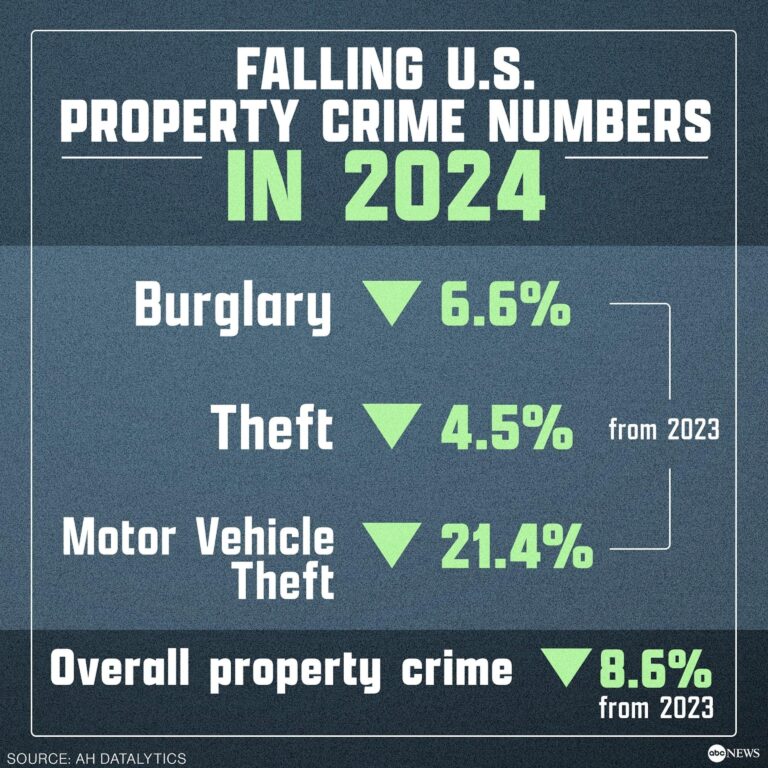The United States experienced a nationwide decline in crime rates in 2024, according to the latest FBI report released this week. The comprehensive data reveals a significant drop across various categories of criminal activity, marking a notable shift in public safety trends compared to previous years. Law enforcement officials and community leaders alike are analyzing these figures to understand the factors contributing to the decrease and to discuss the implications for future crime prevention strategies.
US Crime Rates Experience Significant Decline Across Major Cities
Recent FBI data reveals a nationwide downturn in crime, marking a turning point for many urban areas traditionally plagued by high rates of violence and theft. Major cities such as New York, Los Angeles, and Chicago have reported notable reductions in violent crime, property crime, and drug-related offenses. Experts attribute this positive trend to enhanced community policing strategies, increased investment in social programs, and the expansion of technology-driven crime prevention tools.
Key figures from the report illustrate the scale of this decline:
- Violent crime rates dropped by an average of 12% across 25 largest cities.
- Property crimes including burglary and auto theft decreased by nearly 15% nationwide.
- Drug-related offenses saw a 10% reduction, linked to improved intervention programs.
| City | Violent Crime % Drop | Property Crime % Drop |
|---|---|---|
| New York | 14% | 18% |
| Los Angeles | 11% | 13% |
| Chicago | 10% | 12% |
| Houston | 9% | 14% |
Factors Contributing to the Nationwide Drop in Crime Levels
Several key factors have played a pivotal role in the observed decline in crime rates across the United States. Enhanced community policing strategies, including greater officer engagement and trust-building initiatives, have contributed to more effective crime prevention. Additionally, the widespread adoption of advanced surveillance technology and data analytics has empowered law enforcement agencies to identify and address criminal activity proactively. Economic improvements in certain regions have also provided critical support, reducing factors that often drive crime such as unemployment and poverty.
Other notable contributors include:
- Legislative reforms aimed at sentencing have shifted focus toward rehabilitation, reducing repeat offenses.
- Increased public awareness through educational campaigns and social programs addressing drug abuse and violence.
- Collaboration between federal, state, and local agencies, facilitating resource sharing and coordinated responses.
- Technological innovation in emergency response and communication has shortened reaction times.
| Factor | Impact Level | Illustrative Example |
|---|---|---|
| Community Policing | High | Local neighborhood watch programs expanded 30% |
| Technology Integration | Medium | Use of AI for predictive policing |
| Economic Growth | Moderate | Unemployment rate dropped by 2% |
Impact of Law Enforcement Strategies and Community Programs
The decline in crime rates across the country has been strongly linked to the dynamic interplay between innovative law enforcement strategies and robust community programs. Police departments have increasingly adopted data-driven approaches, such as predictive policing and enhanced real-time monitoring, which have allowed for more targeted interventions in high-crime areas. Additionally, collaborative efforts between law enforcement agencies and local organizations have fostered improved trust and communication, essential components for effective crime reduction.
Community initiatives have also played a pivotal role in this downward trend. Programs focused on youth engagement, mental health support, and neighborhood revitalization have contributed to addressing the root causes of criminal behavior. Key elements that stand out include:
- Youth mentorship programs connecting at-risk individuals with positive role models.
- Substance abuse rehabilitation partnerships reducing drug-related offenses.
- Neighborhood watch networks fostering collective vigilance and cooperation.
- Community policing initiatives promoting accountability and transparency.
| Strategy/Program | Primary Focus | 2024 Impact |
|---|---|---|
| Predictive Policing | Crime Hotspot Identification | 25% reduction in violent incidents |
| Youth Mentorship | At-Risk Youth Engagement | 40% fewer juvenile arrests |
| Substance Abuse Rehab | Drug-Related Crime Prevention | 30% decline in drug offenses |
| Neighborhood Watch | Community Surveillance | 15% decrease in property crimes |
Recommendations for Sustaining and Enhancing Crime Reduction Efforts
To build on the encouraging decline in crime rates nationwide, it is essential to prioritize sustained community policing efforts that foster trust and collaboration between law enforcement and local residents. Enhanced training programs focusing on de-escalation techniques and cultural competency can empower officers to engage more effectively with diverse populations. Moreover, leveraging technology—such as predictive analytics and real-time monitoring systems—can improve resource allocation and crime prevention strategies without infringing on civil liberties.
Investing in social and economic initiatives plays a crucial role in addressing root causes of crime. Programs targeting youth education, job creation, and mental health services can alleviate pressures that often lead to criminal behavior. Below is a summary of recommended focal areas to ensure the momentum in crime reduction continues:
| Key Area | Strategic Focus |
|---|---|
| Community Engagement | Building trust through transparency and neighborhood programs |
| Law Enforcement Training | Emphasizing de-escalation and bias awareness |
| Technology Integration | Data-driven crime prediction and resource management |
| Social Programs | Youth outreach, job skills training, mental health support |
In Retrospect
The decline in crime rates across the United States in 2024, as highlighted in the latest FBI report, marks a significant development in national public safety trends. While challenges remain, the data suggests effective law enforcement strategies and community initiatives are making an impact. Continued monitoring and targeted policies will be essential to sustain and build upon this positive momentum in the years ahead.




